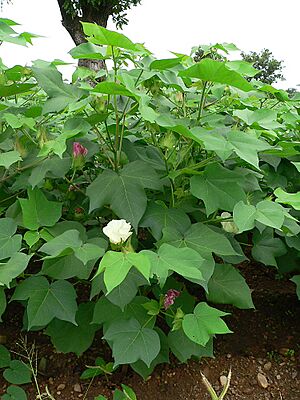Fibre facts for kids
A fibre (also spelled fiber) is a very long, thin, and bendy piece of material. Think of it like a single strand of thread. Fibres are super important! They are the basic building blocks for many things we use every day.
For example, cotton comes from plants, and it's used to make fabric. Silk and wool fibres come from animals. In the 1900s, people also invented many man-made fibres like nylon and polyester.
Fibres are also a big part of how plants and animals are built. They help hold tissues (like muscles or skin) together. People use fibres in many ways. They can be spun together to make thread, string, or rope. Fibres can also be woven into fabric or used in strong composite materials.
Contents
What Are Natural Fibres?
Natural fibres come from plants, animals, or even geological processes (like rocks). We can sort them by where they come from:
- Plant fibres are mostly made of cellulose. You can find them in plants like cotton, hemp, jute, flax, and banana. Plant fibres are used to make paper and textile (cloth). They are also a type of dietary fiber that we eat.
- Wood fibres are taken from trees. Examples include groundwood and different types of wood pulp used for paper.
- Animal fibres are mainly made of proteins. Some examples are silkworm silk, spider silk, wool, and hair.
- Mineral fibres come from minerals found in nature. The asbestos group is an example. Asbestos is the only long mineral fibre found naturally.
- Biological fibres are also called fibrous proteins. These are important proteins in living things. For example, collagen is a protein found in tendons, and actin is a protein in muscle proteins.
What Are Man-Made Fibres?
Man-made fibres are changed or created by people. They include two main types: regenerated fibres and synthetic fibres.
Semi-Synthetic Fibres
Semi-synthetic fibres start with natural materials that have long chains of polymers. These natural materials are then changed using chemicals. The first semi-synthetic fibre was rayon. Most semi-synthetic fibres are made from cellulose.
Cellulose Regenerated Fibres
Cellulose fibres are man-made fibres that come from natural cellulose. This cellulose can come from many places. For example, rayon comes from tree wood fibre, bamboo fiber comes from bamboo, and seacell comes from seaweed.
Some common examples of these fibres are:
- Rayon
- Bamboo fiber
- Lyocell (a type of rayon)
- Modal
- Diacetate fiber
- Triacetate fiber
Synthetic Fibres
Synthetic fibres are made from materials that are completely man-made, like petrochemicals (which come from oil).
Metallic Fibres
Metallic fibres can be made from bendy metals like copper, gold, or silver. They can also be made by shaping or adding layers of metals like nickel, aluminum, or iron.
Carbon Fibres
Carbon fibres are mostly made of carbon atoms. They are often created by heating and changing polymers like PAN. Carbon fibres are known for being very strong and lightweight.
Silicon Carbide Fibres
In silicon carbide fibres, about half of the carbon atoms are replaced by silicon atoms. This makes them different from carbon fibres.
Fiberglass
Fiberglass is another man-made fibre that comes from natural materials. It is made from a special type of glass. Optical fibers, which carry light signals, are also made from very pure quartz (a natural mineral).
Polymer Fibres
Polymer fibres are man-made fibres based on synthetic chemicals. These fibres are made from various materials, including:
- Polyamides like nylon
- PET or PBT polyester
- Polyvinyl chloride fibre (PVC), also known as vinyon
- Polyolefins (PP and PE), known as olefin fiber
- Acrylic polyesters
- Aromatic polyamids (aramids)
- Polyethylene (PE), including very strong types like HMPE
- Elastomers (stretchy fibres)
- Polyurethane fibre
- Elastolefin
Related pages
Images for kids
-
A bundle of optical fibers
See also
 In Spanish: Fibra para niños
In Spanish: Fibra para niños



